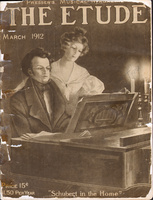Teachers frequently neglect to instruct their pupils in what is known as the “turn” of the bow—the little connecting motion of the wrist after the stroke has reached its limit. This is as important to separate stroke bowing as the springs to a carriage; it connects the strokes smoothly, making a perfect legato, and avoids the jerky, rough, staccato style which is present when these “turns” are not made with the wrist. The “turn” is made at each end of a separate stroke. As soon as the arm stops at the end of a stroke the wrist alone carries the bow a little further, before the reverse stroke is begun, thus connecting the tones, as could be accomplished in no other way. If the wrist is kept rigid at the end of each stroke, the effect on the ear is as if rests were being introduced between the notes, the rests occurring during the process of reversing the bow by the arm. Technical points of this nature are rather difficult to describe in words, but every reader has opportunities of watching and hearing good violinists occasionally, and can watch for this “turn,” which will be seen to be present at the end of each stroke if the violinist knows how to bow properly. This is one of the small details in violin playing which is of the utmost importance, just as in the case of a minute cog in a machine, which is so small as to almost escape notice, and yet it absolutely necessary for the correct running of the machine. Every violin student who finds that he has not been instructed in this matter should lose no time in calling his teacher’s attention to it, and ask to be instructed in it.



